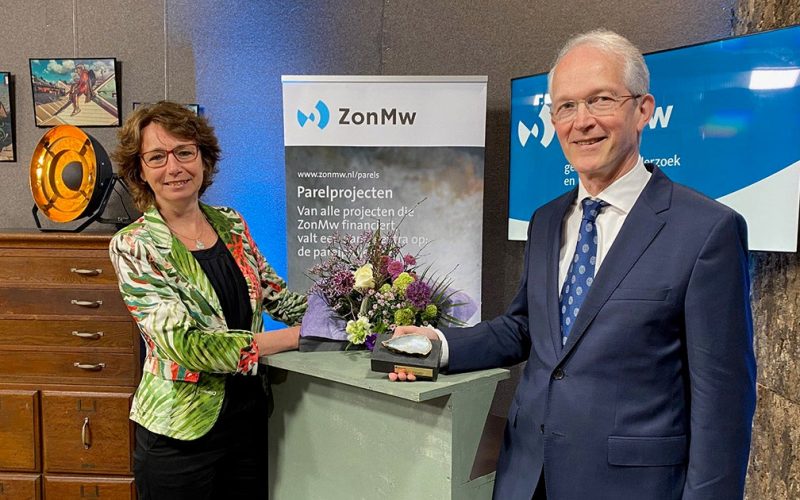Removing as small a brain area as possible to stop epileptic seizures. That is epilepsy surgery. The first step is to locate the probable focus of the epilepsy. If that part of the brain is expendable, it will be removed. Very often successfully. But sometimes you remove the focus while the epilepsy remains. New research based on mathematical models offers surprising insights and shows that the brain works differently than thought. On May 20, 2021 ZonMw granted this UMC Utrecht research a Pearl.
The different brain areas are interspersed with a large network of nerves, including several busy complex nodes. Neurologist Frans Leijten explains that epilepsy often originates at one place in the brain. “In fact, that place is over-stimulated.” In some epilepsy patients for whom surgery is being considered, electrodes are first placed on their brains, inside the skull, followed by a week of EEG monitoring. “We measure the electrical activity, but we can also administer currents ourselves and see connections. We can chart the focus, what the network around it looks like and what the function of that area is. Based on that, we assess whether that part can be done without, after which it is surgically removed. That often works, but not always. The funny thing is that sometimes it has no effect at all.”
Together with UMC physicist Geert Jan Huiskamp and applied mathematicians Hil Meijer and Stephan van Gils from the University of Twente, Frans came up with the idea of using mathematical models that mimic the brain activity of these patients. Frans calls it real out-of-the-box research. “We first had to learn to understand each other’s language. Mathematicians are really into logic and structure, whereas I am more into practice.” On behalf of all researchers involved, Frans Leijten received the Pearl on May 20 from ZonMw director Veronique Timmermans during the online talk show “Zicht op 15 jaar translationeel onderzoek” [15 Years of translational research in view]. Leijten: “I think it’s a tremendous honor that our research has been selected.”
Ultimately, the goal is to mimic the unique brain network of an individual patient 1-to-1 in a mathematical model. “Our model has the same network structure as we see in the patient in question. In it, you can simulate on the laptop what happens in case of a seizure. Toying with such networks quickly produced surprising insights. We sometimes saw effects that we do not yet understand clinically. For example, we sometimes saw that the epileptic activity takes place in brain area x, whereas an apparently normal brain area y stirs up the activity. If you remove brain area x in such a case, the activity may move to another part. This could explain why sometimes we see no effect when we remove the apparent epileptic focus.”
Something else that the models quickly made clear was that it is not only the epileptic foci that are important, but also the structure of the connections around them. “The models show the route by which the epileptic activity spreads. By breaking that route, it is also already possible to reduce epileptic seizures.” In current practice this sometimes happens already, but then the decision is more or less based on a guess. For example, Frans remembers a patient. “This man had several severe seizures a day. He was desperate, he couldn’t live with it. When we located the focus, it turned out to be in the middle of an essential language area, something you can’t do without. But we also saw that many connections went to the hippocampus. It was a gamble, but for this man it was a sure thing: something had to be done. So we removed the hippocampus. To our surprise, this man hasn’t had a seizure since the surgery.”
Of course, you’d rather not do such a risky operation based on a guess. “This mathematical model makes it possible to mimic in a patient where the epilepsy originates and how it spreads. And that is not always visible to the eye. It also demonstrates that sometimes the real focus cannot be removed, but that the epilepsy can be contained by removing one or more connections. The good thing is that in the model you will soon be able to test on the computer what happens when a part of the brain or connection is removed. This way you can figure out what works best for this patient before you actually start cutting. In this way, we gain a much better insight and grip.”
The researchers are still working on methods to improve the mathematical models and make them practically useful. “The greatest dilemma now is that it takes a lot of time to map out an individual’s network. Not all patients undergo a long-term examination with electrodes on the brain. You actually want to use the method during surgery when everything is accessible, but then you can’t spend hours on measurements and complicated calculations. Speed is one of the things we are still working on. In time, modified versions of these mathematical models can also be used for other diseases, such as dementia for example. I expect a lot from that.”
Progress in healthcare requires research and development. The Netherlands Oranisation of Health Research and Development (ZonMw) promotes and finances health research, care innovation and the use of developed knowledge. ZonMw’s clients are the Ministry of Health, Welfare and Sport and the Netherlands Organisation for Scientific Research. The Pearl is an award that is presented several times a year to ZonMw projects that can serve as an example and inspiration for the projects that receive a ZonMw grant.
